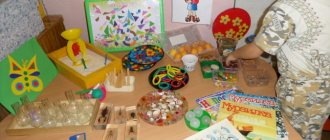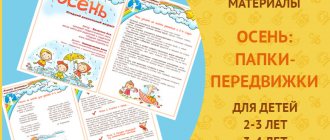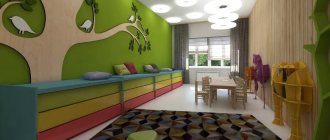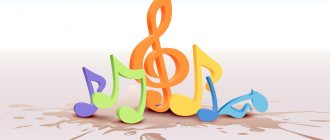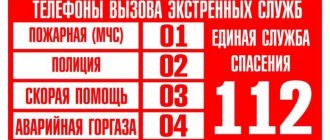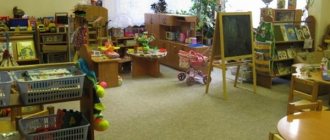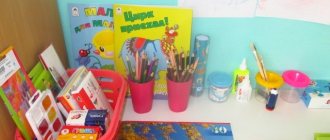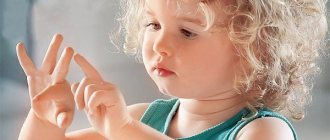Many psychologists and modern teachers note the influence of music on the formation of a child in preschool age. Dancing, singing, and playing a variety of musical instruments helps to intensify mental activity and develop a sense of beauty in the younger generation. Musical corners in kindergartens contribute to solving the tasks that the state sets for preschool educational institutions.
Features of creation
To begin with, let’s analyze the possibility of artistic and aesthetic development of children in a preschool institution. Musical corners in kindergarten are a way to inform children and parents about the impact of art on the development of the emotional qualities of children. Thanks to music classes, children develop diversified, improve their oral speech skills, and improve their auditory perception.
By mastering rhythm skills, it will be easier for children to learn mathematical operations while studying at school. At the age of 1.5-3 years, preschoolers acquire the skills of extracting sounds from simple musical instruments and consciously use the terms “ri.
The teacher periodically updates the music corners in the kindergarten, placing relevant and useful information in them.
Forms of musical work in preschool educational institutions
Among them, we note integrated and standard classes. A music corner in a kindergarten, the design of which is undertaken by the music worker himself, contributes to the children’s positive attitude towards the lesson. The teacher only accompanies the children to class and acts as an organizer.
The children come to the music room in kindergarten with him. Rhythmic and musical games, listening to songs and compositions are also included during walks and excursions.
How to set up music corners for different age groups
Svidinskaya T.V. How to equip musical corners in different age groups // Sovushka. 2022. N2(12). URL: https://kssovushka.ru/zhurnal/12/ (access date: 01/18/2022).
Order No. 89679
When children are free, they show individual inclinations: they draw, sculpt, sing, play music with the help of children's musical instruments, that is, they act independently. In order for this activity to develop as successfully as possible, it is necessary to create appropriate conditions: allocate a place for classes, arrange a music corner and equip it with aids.
In the corner there should be a shelf for musical aids and educational board games. The main content of the corner consists of various musical aids. These are musical toys and children's musical instruments, which are selected taking into account the age of the children and the sequence of familiarization with a particular instrument during musical lessons. Musical toys are most often used in story-based and educational games. They are mainly used by very young children (rattles, pipes, bells, etc.). Of course, they are greatly simplified and do not completely reproduce the sound of real ones, although sometimes they bear their names and are similar in appearance. These are a variety of teaching aids and games, some of which are homemade. There are also attributes and costume elements used by children in musical games, dramatizations, and dances.
To develop pitch hearing, you can use bells that sound different in pitch, and children will learn which bell “sings” higher and which lower.
To develop rhythmic hearing, it is better to use all instruments of the percussion group or any instrument that has the sound of only one specific pitch. For example, children play “musical echo”: one child comes up with his own rhythm, and the other repeats it exactly.
For the development of timbre hearing, it is very useful to compare the sound of a string, wind or percussion group, but also to invite children to note homogeneous instruments that are similar in timbre and sound character, for example, bells and tambourines, metallophones and triangles.
Recommendations for equipping music corners.
In kindergarten, in order to introduce a child to music and develop his musical abilities, various musical instruments, toys, paintings and visual aids are used. The success of music education largely depends not only on sufficiently equipping classes with didactic aids and other materials, but also on their correct use outside of class, taking into account the age of the children, their interest and the specific capabilities of the kindergarten.
Children of the younger group are given percussion instruments: tambourine, drum, rattles, bells and noise instruments - rattles, rustles.
From the middle - you can add wooden sticks, wooden spoons, a metallophone (in the second half of the year) as well as various boxes with fillings.
The older ones are rumba, triangle metallophone, as well as noise instruments.
Preparatory - maracas, rattle, castanets, xylophone, zither and noise instruments that can be used in role-playing games.
Throughout the year, toys and aids are changed, put away and brought back again in order to maintain interest in them and the desire to act with them.
It is advisable for each group to have a tape recorder and a small set of cassettes or disks with recordings of children's songs, folk dance melodies, and musical fairy tales. In this case, the teacher will be able to satisfy the children’s desire to listen to music, dance, sing or just play.
Literature:
- Zatsepina M.B. Musical education in kindergarten. M., 2008.
- Arsenevskaya O.N. System of musical and recreational work in kindergarten. Volgograd, 2011.
- Arsenevskaya O.N. Musical lessons. 1st junior group. Volgograd, 2012.
- Butenko E.V. Musical games and entertainment. 2-3 years. M., 2011.
- Sorokina N.F. Puppet theater for the little ones.
- Radynova O.P. Musical development of children. M., 1997.
- Yurchuk E.N. Emotional development of preschool children.
- Toys and aids for kindergarten / compiled by L.F. Ostrovskaya; edited by V.M. Izgarsheva. M.: Education, 1982. 175 p.
Subject-spatial environment of the group
This function is performed by music corners in kindergarten. Here the kids consolidate the material received during the lesson with the music worker. At the basis of aesthetic development, the teacher uses group forms of work:
- memorizing dance moves;
- learning new children's songs;
- acquaintance with the work of domestic and foreign composers.
Musical corners in kindergarten, according to the Federal State Educational Standard, should encourage kindergarten students to independently study simple musical instruments, demonstrate their creative abilities and capabilities by composing melodies, dance movements, and singing songs.
The kids like to come up with melodies and perform them in front of their peers. To intensify such work, the teacher tries to conduct a variety of musical games for children.
Memo for educators on the topic “Design and equipment of musical corners in preschool educational institutions”
Memo for teachers on the topic:
“Design and equipment of musical corners in preschool educational institutions”
In independent activity, children have individual needs and desires: some draw, others sculpt and build, others play musical instruments and sing. For such activities to develop successfully, it is necessary to create favorable conditions.
For the full musical development of a child, it is necessary to provide the opportunity to independently play musical instruments, play music, and consolidate acquired skills and abilities with the help of musical games, aids and attributes.
You should consider the conditions for placing a music corner:
1. Availability of music corner equipment for children.
2. Variety of music corner equipment.
3. Taking into account the age characteristics of children when creating a music corner
4. Aesthetic design of the music corner and its equipment.
Music corner equipment includes:
• Toys, illustrations, fake musical instruments (for creating play situations in which children imagine themselves as musicians).
• Children's musical instruments and toys for playing music:
- with a chromatic, diatonic series (piano, metallophone, accordion, etc.);
— with a fixed melody (organs, organs);
— with one fixed sound (pipes);
- noise (tambourines, rattles, drums, maracas, etc.).
• Musical and didactic games and manuals (Note lotto, stave, musical ladder, games appropriate for the age and individual characteristics of children).
• Audio, video discs and cassettes.
In a preschool institution, for the successful musical development of a child, various musical instruments, a variety of musical games and aids are used not only in direct musical activities, but it is also necessary that in the group they find the correct use, taking into account the age characteristics of the children:
- JUNIOR GROUPS
- Vanka - stand up;
- musical “singing” or “dancing” toys (cockerel, cat, bunny, etc.);
- musical instruments with a fixed sound - organs, organs;
- noise instruments: rattles, bells, tambourine, drum;
— unvoiced fake musical instruments (accordions, pipes, balalaikas, etc.);
— attributes for musical outdoor games;
— flags, plumes, scarves, bright ribbons with rings, rattles, autumn leaves, snowflakes for children’s dance creativity (replenished as needed);
— table screen with glove toys;
— tape recorder and a set of software audio recordings;
- musical pictures for songs, which can be made on a cube, in the form of an album, or individual colorful illustrations.
- MIDDLE GROUP
It is advisable to leave manuals, attributes and musical instruments from the younger group and add:
-glockenspiel;
- noise instruments for children's orchestra;
— books “Our Songs” (each book illustrates a song familiar to children);
- flannelograph or magnetic board;
— musical and didactic games: “Musical Instruments”, “Sounding Palms”, “Rhythmic Sticks”, etc.
- attributes for outdoor musical games: “Cat and Kittens”, “Bunny”, “Hares and Bear”, “Pilots”, etc.;
- musical ladders (three-stage, on which there are small and large birds or a small and large nesting doll;
- ribbons, colored scarves, plumes, etc. (attributes for dance improvisations for the season);
— table screen and a set of toys;
- tape recorder and a set of software audio recordings.
- SENIOR GROUP
In addition to the equipment of the middle group music corner, the following is used:
- rattles, tambourines, drums, triangles;
— musical toys-instruments with chromatic and diatonic sound (metallophone, piano, button accordion, accordion, flute);
— illustrations on the topic: “Seasons”;
— homemade musical toys (Children will be happy to take part in making instruments for a noise orchestra);
— musical and didactic games: “Learn a song by two sounds”, “Jingle bells”, “Musical ladder”, “Rhythmic lotto”, etc.;
— attributes for outdoor games;
- children's drawings for songs and familiar pieces of music.
- table screen and screen according to children’s height;
— five-step and seven-step musical ladders;
— attributes for children's dance creativity: elements of costumes for familiar folk dances.
- PREPARATORY GROUP
In addition to the material used in the senior group, the following is added:
— musical instruments: maracas, tambourines, harp, children's piano, metallophone, bells, triangles, flutes, drums;
— portraits of composers;
— folder-albums: “We are drawing a song” with children’s drawings, in which they reflect emotions and feelings about the pieces of music they listened to and their favorite songs;
— a manual “Emotions” (cards depicting faces with different emotional moods) for determining the nature of the melody when listening to music;
— visual aids: “Symphony Orchestra”, “Folk Instruments”;
— homemade instruments for a noise orchestra;
— musical and didactic games
Goals of creating a music corner in a preschool educational institution
It consists of instilling and improving the individual abilities of preschoolers, developing the skills of emotional response to musical and song images. The teacher instills in his students a culture of listening to music. The teacher himself decides what to call the music corner in kindergarten. It is desirable that the name resonates with the art. For example, you can design a corner “Merry Notes”, or create a “Song Gallery”.
Children, after listening to vocal or instrumental performances of rhythmic melodies, try to convey their meaning through movements or words. This helps improve their communication skills.
Musical games for children are aimed at developing logical thinking and perseverance. For example, in the game “Repeat After Me,” kids make the same movements to the music as their teacher. As soon as the music stops, they must sit on the chairs and “hide in their house.”
Children are happy to be involved in all musical activities in kindergarten and become active participants.
Music and information corner in kindergarten groups
Decorating a preschool educational institution with your own hands
Author: Svetlana Nikolaevna Kryuchkova, music director of MDOU Kindergarten No. 127 “Northern Fairy Tale”, Petrozavodsk Description of work : information is useful for music directors and kindergarten teachers. Interaction between parents, teachers and music director gives good results in musical development preschoolers. This option of working with parents through information folders takes place in our kindergarten. Goal: to help inform parents and educators about the musical development of children. I have been working as a music director for more than 10 years. When I first started my career, mothers often approached me with requests to rewrite the songs that we learn in music classes. They shared positive emotions from the children talking about what or who they sang in class or how they danced. But they can help their children remember certain words from their favorite songs at home, since they don’t know them. At the request of the parents, I rewrote and photocopied the lyrics of the songs... The teachers also asked for the lyrics of the songs so that they could repeat them with the children when they had a free moment. Each group had a notebook where I wrote down the words of the songs. A lot of time was spent on this rewriting of texts... And then I came up with the idea of creating an information corner
on the musical education of preschoolers in each group.
So I came up with a folder of information that I called “Music Corner” . In one part of the folder there is a pocket where I put the lyrics of the songs that we learn in music classes. Interested parents can rewrite the songs themselves, and teachers can take the words of the songs from the pocket at any time and repeat them with their children.
A lot of song lyrics have accumulated, so we have a whole card index by season (autumn, winter, spring, summer...). Every year, the card index is replenished with a new song repertoire.
On the other side of the information folder, I put useful and interesting information in a file. Thanks to the Internet, there is now such an abundance of various interesting information on the musical development of children that I am happy to share it with parents and educators. Here are some of the information articles for parents: “Age characteristics of children (2-3, 3-4, 4-5...) years”, “Holidays in the family”, “Theater at home”, “Sing to children before bed”, “ The history of the winter holiday”... and so on.
I try to fit the information into one sheet of A4 format, so that parents have time to read it in the evening while they are waiting for their children in the locker room. Aesthetically designed information (drawings, color highlights) attracts the attention of parents, so I pay attention to this. I collect all articles in folders. There are a lot of articles, so I’m dividing them by topic. For example: “Theater at home”, “Music therapy”, “Holidays and entertainment in the family”, “On the role of music”, etc. I change the information monthly, or even 2-3 times a month, which depends on the tasks and goals of the preschool institution. Experience shows that such “Musical Corners” are great assistants in the work of a music director. The interest of educators, and even more so of parents, affects the level of children’s assimilation of the repertoire, as well as the musical development of preschoolers.
We recommend watching:
My favorite Kuban kindergarten Corner of theatrical activities for children of the first junior group Duty corner in kindergarten
Master Class. Twine well
Similar articles:
Do-it-yourself panels for decorating a corner of nature in a kindergarten
Aerodesign. Master Class
Decorating a group and reception area in a kindergarten with your own hands.
DIY Autumn panel
Poetic design for a kindergarten group
Interesting Facts
The results of psychological research indicate that children who are exposed to music from an early age have a higher intellectual level and demonstrate excellent logical thinking.
Musical games in kindergarten are organized not only as part of classes, but also when organizing holiday matinees. Moms and dads listen with great pleasure to songs performed by their babies, watch their rhythmic movements, and admire playing the simplest musical instruments.
What musical instruments do teachers use for children? First of all, these are spoons, playing on which contributes to the formation of a sense of rhythm.
Objectives of the music corner
They are determined by thematic and calendar planning drawn up by the teacher. The work of the corner is coordinated with the music worker. Together, teachers choose works that the children will listen to in class. Musical games in kindergarten are also selected by both the teacher and the music teacher. Basically, they are chosen for specific holidays and creative matinees. For example, the game “Pick a Bouquet for Mom” is held during a festive concert dedicated to the celebration of March 8 in a preschool institution. Children “pick flowers” to the music, demonstrating rhythmic dance movements to their parents.
Musical instruments for children often become a means of developing aesthetic culture, a way of getting to know the cultural heritage of their people.
In the music corner, the teacher can post additional information, thanks to which children and their parents will learn about the history of the appearance of instruments.
Taking into account the age characteristics of preschool children
When designing a music corner, the teacher is guided not only by the recommendations of the educational standards of the new generation, but also by the age and individual characteristics of his students. For example, 2-3 year old children will be interested in pictures that are associated with music: unusual notes, colorful musical instruments. The peculiarity of the musical development of children of this younger preschool age involves the formation of elementary concepts about tempo, rhythm, melody, sound and the name of musical instruments.
The teacher develops his students’ vocal abilities and attentiveness in performing and listening to the material.
Within the framework of music lessons, a sense of responsibility for actions taken and sustainable motivation to work in a team is formed.
MAGAZINE Preschooler.RF
Implementation of the Federal State Educational Standard in a kindergarten Recommendation for teachers of preschool institutions“Creation of a creative musical zone in the light of fulfilling the requirements of the Federal State Educational Standard”
EDUCATION LAW: Article 48. Teaching staff are obliged to: develop students' cognitive activity, independence, initiative, and creative abilities.
FEDERAL STATE EDUCATIONAL STANDARD OF PRESCHOOL EDUCATION:
I. GENERAL PROVISIONS:
2.4. The program is aimed at:
creating conditions for the child’s development that open up opportunities for his positive socialization, his personal development, the development of initiative and creative abilities based on cooperation with adults and peers and age-appropriate activities; to create a developing educational environment, which is a system of conditions for the socialization and individualization of children.
II. REQUIREMENTS FOR THE STRUCTURE OF THE EDUCATIONAL PROGRAM OF PRESCHOOL EDUCATION AND ITS SCOPE:
2.6 Program content:
Artistic and aesthetic development presupposes the development of prerequisites for the value-semantic perception and understanding of works of art (verbal, musical, visual), the natural world; the formation of an aesthetic attitude towards the surrounding world; formation of elementary ideas about types of art; perception of music, fiction, folklore; stimulating empathy for characters in works of art; implementation of independent creative activities of children (visual, constructive-model, musical, etc.).
Recommendations:
Creating a creative zone in a group is necessary for the development of the musical and creative abilities of a preschooler. This is an integral part of the entire pedagogical process, which is very important for nurturing aesthetic, cultural and moral qualities in a child, as well as for identifying and developing his creative and musical abilities.
Where to start creating such a creative zone?
I Study the recommendations for teachers on organizing and designing a music corner in a group.
II Together with the music director, select equipment
by sections that correspond to this age group:
2.1. Listening:
-Purchase portraits of famous Russian and foreign (including modern composers (M. Glinka, P. Tchaikovsky, D. Kabalevsky, A. Mozart, L. Beethoven, I. Bach, Krasev); -Replenish the music library on listening and perceiving music ( classical, children's, thematic and modern musical works) -Purchase DVDs with educational information about art -Select illustrations of musical instruments, sheet music, pictures of animals singing, dancing or playing musical instruments.
2.2.Playing children's musical instruments:
-Fake musical instruments - toys (made by teachers, together with children) - these are not voiced flat musical instruments made of thick cardboard or thin plywood, which are needed to create a play situation in which children, fantasizing, imagine themselves as musicians (piano, accordion , balalaika); — Material for creative role-playing games are soft toys, soft musical toys, tumbler dolls, figurative musical singing or dancing toys (dog, cat, cockerel, bunny); -Children's musical toys and instruments for creative music-making: children's piano, accordion, a metallophone is added from the middle group; -Sounded toys: (musical hammer, barrel organs, guitars, rattles, musical tops) Children examine them, try to extract individual sounds or a fixed melody from them; -Noise instruments: tambourines, rattles, drums, maracas, small and large bells, bells, spoons.
2.3 Singing and singing along:
-Keep a notebook for recording songs, poems, nursery rhymes learned in music classes; — Purchase audio recordings of the pros and cons of the song material being learned.
2.4 Didactic games:
- “Sun or rain” (for distinguishing the nature of music - “Quiet-loud” (for distinguishing dynamics) - “Guess what I’m playing” (for the development of timbre and pitch hearing) - “Rhythmic nesting dolls” (for the development of rhythmic hearing)
III Create a folder with theoretical material:
3.1 Consultations for educators: 3.2 Consultations for parents: 3.3 Scenarios for musical matinees held in a group.
When designing a musical and creative area, you need to remember the age and individual capabilities of children. So, for children 3-5 years old, it is better to build the design on a plot basis, and for older children - on a didactic basis. The musical object environment must correspond to the eye, the actions of the hand, and the growth of the child. The music corner should have a cabinet, shelves for musical aids, a table, and chairs for educational games. The aids of the developing environment are of good quality, aesthetically pleasing, attractive, easy to use, and evoke a desire to act with them. There should be carpets and soft ottomans on the floor. This creates comfort and promotes concentration. It is better to put a DVD player in the corner, with which children can listen to music, various cartoons, as well as melodies that promote psychological relaxation and mental relaxation. Usually, stands are hung on the walls of the music corner. Lyrics of songs, poems, ditties, photographs of children's performances, composers, colorful posters, pictures of musical instruments are attached to them. The music corner can be designed very interestingly and brightly - in the form of a stage podium, on the steps of which the necessary aids for musical education are located, also in the form of a pyramid, in younger groups - on various characters sewn from fabric, these can be Parsley, a matryoshka doll, a snowman. A creatively designed music corner will not only help you plunge into the world of music and expand your understanding of it, but will also develop children’s imagination, activate the emotional sphere, thinking, and speech. The music corner can be designed together with other corners, for example, with speech or educational ones. An interesting design option is to combine music and theater areas. I propose to place the following types of theaters in the music corner: 1. Picture theater (Flannelograph). (How to make) Cut out fairy tale characters from cardboard, and glue pieces of flannel on the back side; such figures will stick perfectly to plywood covered with flannel. With the help of visual accompaniment of pictures and toys, children learn to follow the actions of characters in short poems, nursery rhymes, and fairy tales. 2. Finger theater (a doll can be made from cut-off gloves, eyes, ears, and pigtails can be attached). Games with finger puppets will help your child learn to control the movements of his own fingers. 3. Table theater (Russian folk tales) In order for children to constantly maintain interest in independent musical activities, it is necessary to update the manuals in the music and theater area 1-2 times a month and introduce new equipment.
| Next > |
Work in the middle group
With children 4-5 years of age, the music worker not only learns songs and dance movements, but also teaches children to play simple musical instruments and involves them in play activities.
For example, as part of a lesson aimed at learning strings, wind, and percussion instruments, preschoolers are invited to try themselves as performers of certain rhythmic compositions. During the game, the teacher first voices a rhythm, then the kids try to repeat it one by one. This technique contributes to the early identification of musical and talented children and their subsequent development. The teacher encourages children to improvise in various types of musical activities: dance composition, melody, chant.
Components of work
The vocabulary of preschoolers aged 5-6 years includes the following musical terms: forte, minor, piano, major, staccato, legato. It was during this period that children’s ideas about the musical culture of various peoples of the world expanded. In the music corner, children actively participate in instrumental work. For example, they learn a melody and even try to perform it with an orchestra. In order to increase the educational and educational effect of such activities, the children, under the guidance of their “conductor,” perform in front of their fathers and mothers. Of course, involving preschool children in joint work is an important aspect of developing their active citizenship, and therefore, full compliance with the state order. Children who acquire teamwork skills from early childhood feel responsible for their actions, which makes it easier to establish relationships with other people.
Modern tendencies
The material base of the music corner in kindergarten is replenished annually. For example, musical toys are selected for the youngest children, and real musical instruments are purchased for older preschoolers.
In recent years, groups for children aged 1-1.5 years have appeared in many kindergartens. In the musical corner of such a group there can be a variety of toys: rattles, tumblers, hammers, accordions, whistles. Some items that are then placed in the “music corner” are made in classes by children from the senior groups of the preschool educational institution.
The teacher also attracts the parents of their students to such productive creativity. For example, a chocolate surprise box filled with cereal will make an excellent rattle and take its rightful place in the “orchestra.” You just need to attach sticks to this design, and you can get an unusual rattle for a 1.5-2 year old baby.
Maracas are created using a similar technology, which will require plastic containers from drinking yogurt.
An analogue of a tambourine can be made from bottle caps, strung on thick wire. The basis for the drum is a wide mayonnaise jar. Armed with creative imagination and waste materials, you can create an original music corner in your kindergarten.
In addition to such original options, prop instruments are also used in any musical corner. For example, they can be drawn on thick cardboard or created from papier-mâché. Of course, they are not capable of producing musical sounds, but they perfectly convey the external characteristics of a harp, piano, accordion, and are suitable for playful work. Prop-type instruments perform an educational task; with their help, preschoolers develop ideas about genuine musical instruments and their purpose.
Consultation for teachers “Music Corner”
Music corners should contain:
- Neo-sounding musical instruments;
- O sonorous musical instruments;
- Musical toys;
- Homemade musical instruments;
- Musical and didactic games;
- Technical means (audio and video recordings).
The corner is updated 1-2 times a quarter!
- introduce new musical and didactic games,
- new equipment and homemade musical instruments.
“Musical corner of the 21st century” or “Modern trends”
The group must have audio and video equipment, CD and DVD players, headphones (for older preschool age), so that one child does not disturb others while listening to music.
A selection of children's contemporary songs and classical music in accordance with the age category of children.
High-quality sound of musical instruments (including electronic ones), i.e. well-tuned and producing sounds familiar to children (so as not to pollute the child’s auditory experience).
Answer the questions:
- What is the main purpose of the music corner:
- teach musical literacy
- develop creativity
- cultivate aesthetic taste
- strengthen the physical and mental development of the child?
- What levels is the music corner divided into and why?
- How many times are manuals and materials updated per year?
- What do modern trends require?
Musical corners in groups.
List of materials for children from 2.5 to 4 years old
(1st and 2nd junior groups):
- tumbler dolls;
- figurative musical “singing” or “dancing” toys (cockerel, cat, bunny, etc.);
- toys-instruments with a fixed sound - organs, organs;
- toys-instruments with a sound of indefinite pitch: rattles, bells, tambourine, drum;
- a set of unvoiced figurative instruments (accordions, pipes, balalaikas, etc.);
- attributes for musical outdoor games;
- flags, plumes, scarves, bright ribbons with rings, rattles, autumn leaves, snowflakes, etc. for children's dance creativity (by season);
- table screen with glove toys;
- tape recorder and a set of software audio recordings;
- singing and moving toys;
- musical pictures for songs, which can be made on a cube and in the form of a large album or individual colorful illustrations.
List of materials for children 4-5 years old
(middle group of kindergarten):
In the music area for independent activities of children 4-5 years old, it is advisable to have:
- glockenspiel;
- noise instruments for children's orchestra;
- little books “We Sing” (they contain bright illustrations of familiar songs);
- flannelograph or magnetic board;
- musical and didactic games: “Three Bears”, “Recognize and Name”, “In the Forest”, “Our Orchestra”, “Seven-Flower Flower”, “Guess the Bell”, etc.;
- attributes for outdoor musical games: “Cat and Kittens”, “Hen and Cockerel”. “Hares and the Bear”, “Pilots”, etc.
- musical ladders (three-step and five-step, on which there are small and large birds or a small and large nesting doll;
- ribbons, colored scarves, bright plumes, etc. (attributes for dance improvisations, but for the season;
- table screen and a set of toys;
- musical toys (sounding and noise) for creative music making:
- tape recorder and a set of software audio recordings.
List of materials for children 5-6 years old
(senior kindergarten group):
In addition to the middle group materials, the following is used:
- rattles, tambourines, drums, triangles, etc.
- musical toys-instruments with diatonic and chromatic sound (metallophone, piano, button accordion, accordion, flute);
- illustrations on the theme “Seasons”;
- homemade musical toys (noise orchestra);
- portraits of composers;
- illustrations from the “Musical ABC Book”;
- musical and didactic games: “Bee”. “Musical Lotto”, “Recognize and Name”, “Steps”, “Repeat the Sounds”, “The Three Little Pigs”, “Magic Top”, “Musical Train”, “Guess What Sounds”, etc.
- attributes for outdoor games (“Round Dance in the Forest”, “Raven”, “Cat and Mice”, etc.);
- children's drawings for songs and familiar pieces of music;
- screens: tabletop and screen according to children’s height;
- three-, five- and seven-step musical stairs - voiced;
- attributes for children's dance creativity: elements of costumes for familiar folk dances;
- multi-colored feathers, multi-colored gloves for musical improvisations behind a screen and other attributes;
- attributes for dance improvisations according to the season - leaves, snowflakes, flowers, etc.):
- a tape recorder and a set of software audio recordings or disks.
List of materials for children 6-7 years old
(preparatory group of kindergarten):
- musical instruments (maracas, tambourines, harp, children's piano, metallophone, bells, triangles, flutes, drums, etc.);
- portraits of composers;
- illustrations on the theme “Seasons”;
- pictures for the manual “Musical ABC Book”;
- albums: “We draw a song” or “We draw and sing” with children’s drawings, in which they reflect their emotions and feelings about the pieces of music they listened to and their favorite songs;
- graphic aid “Emotions” (cards depicting faces with different emotional moods) to determine the nature of the melody when listening to works;
- albums for viewing: “Symphony Orchestra”, “Folk Instruments”, “Dances of the Peoples of the World”, etc.;
- musical stairs (three-, five- and seven-step - voiced);
- a set of homemade instruments for a noise orchestra;
- musical and didactic games: “Three Little Pigs”, “Three Flowers”, “Musical Umbrella”, “Ri”, “Rhythmic Cubes”, “Name the Composer”, “Funny Record”, “Musical Chicks”, etc.;
- attributes for outdoor games (for example, “Hello, autumn”, “Cosmonauts”, etc.);
- attributes for children's dance creativity, costume elements for familiar folk dances (kerchiefs, wreaths, hats) and attributes for dance improvisations according to the season (leaves, snowflakes, flowers, etc.); multi-colored gloves, plumes, gauze or scarves, multi-colored ribbons, multi-colored feathers for music and dance improvisations; tape recorder and a set of software audio recordings or disks »
CONSULTATION FOR TEACHERS
TOPIC: ROLE OF THE TEACHER IN MUSICAL CLASSES AND HOLIDAYS
Among the many recent problems related to preschool education, the problem of interaction between educators and specialists stands out. And the problem of pedagogical interaction between the teacher and the music director is one of the most important: the success of the process of not only musical, but also the general aesthetic development of preschool children depends on its solution.
We, music directors, would like to see the interest of teachers in the process of music lessons. When a child sees that the teacher completes all the tasks with interest, he becomes involved in the process with even greater inspiration. After all, the teacher is an absolute authority for him, and no matter what happens in class, the child will constantly focus on the teacher.
How does a teacher’s interest in a music lesson show? First of all, the teacher needs to understand that in a music lesson he is as much a participant as the children, and not an overseer. Imagine that you are a child, everything is interesting to you and you and your children cheerfully sing songs, dance fervently, listen to music thoughtfully... And you do this not as a duty, but with your soul, but do not forget that there is a pedagogical process that needs to be controlled.
And now let’s move on from aesthetics to organizational issues.
SO:
1. During a music lesson, children should be smartly dressed,
wear comfortable shoes, girls must wear skirts.
2. starting from the middle group of children, it is necessary to build, alternating
boy and girl.
3.You should arrive to class 2-3 minutes before the start so that
line up and get the children ready for the activity.
4. The teacher brings with him a notebook with a hard cover on
spirals and pen to write down words of songs, games, movements
dances, recommendations, etc.
5. During class, it is advisable not to leave the hall, so as not to
skip some material.
6.Do exercises with the children. Movements of dances, games,
sing songs, etc.
7.Monitor the children’s movements correctly
8.Before class, it is necessary to maintain musical silence: do not
turn on the tape recorder, since children have hearing loss
perception and concentration
9. In free activity, consolidate the material received in class.
Nitophone, audio materials.
